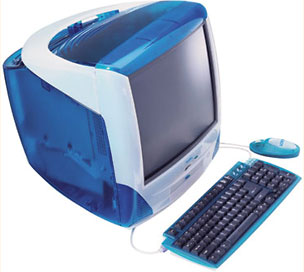1998.11: Steve Wozniak says that Apple won because all of today’s computers look like Macs. Bill Gates thinks Microsoft Windows won because he “borrowed” all of Apple’s good ideas.
Sorry, but it just isn’t so.
I recently had my first Nightmare with Windows. At work, we figured it made more sense to buy an inexpensive Windows computer than upgrade a Mac to the point where it could handle Virtual PC. It was probably a mistake.
Sure, there’s a strong visual resemblance between the Mac OS and Windows. There’s also a visual resemblance between some of those VW body kits and certain classic cars. That doesn’t mean they’re the same thing.
Removable Media
For instance, on every Mac with a floppy drive, every Mac with a CD-ROM, and every Mac with a removable media drive (Zip, Jaz, SyQuest, whatever), the computer knows when there’s a disk present. Pop it in and watch the Finder mount it on your desktop.
That’s because Apple designed both the hardware and the software. In the DOS world, a computer doesn’t know if you’ve stuck in a floppy disk. It may not recognize a Zip disk or CD, either, until you tell Windows to look for it.
The Mouse
Every Mac knows what to do when you move the mouse or click the button. But in the Windows world, you need a software driver. Nice thing is, it does come with Windows and it does work with most mice.
Your Monitor
We in the Mac world have been spoiled. Since 1987, we’ve been able to change bit-depth (the number of colors or shades of gray displayed) on the fly – no need to restart the computer. And not long after that, the first video cards to support on-the-fly resolution switching came along.
Windows 95 never supported that. Windows 98 tries to, but it really wants you to restart the computer when you make changes like that. It actually begs you to do so.
Can You Hear Me?
I’m incredulous. The Compaq Presario we have at work can’t even beep unless you hook up speakers or have an AV monitor.
Every Mac ever made has a built-in speaker, and we never have to worry about sound cards.
That’s integration.
Hard Drives
Ever since 1986, we’ve been able to attach up to 7 SCSI drives to our Macs. Give each one a unique ID and daisy-chain them together, but don’t worry about things like the number of platters, heads, sectors, and tracks. SCSI handles all that for us.
They’re getting there in the Windows world, but it will probably take USB and FireWire to make it as easy as it’s always been on the Mac.
Networking
Windows people still think networking is a cutting-edge option. Every Mac since the Mac Plus has built-in networking: LocalTalk, ethernet, and sometimes both. The iMac bumps it to the next level with 100 Mbps ethernet.
Two Macs plus a cable makes a network. Two PCs plus a cable makes . . . a pair of computers.
iMac Competition?

eMachines eOne, an early iMac look-alike.
Sure, the Wintel world wants to steal Apple’s thunder. They’ll design new computers that copy the iMac design. We’ll probably start seeing them after Christmas.
Of course, in January the Mac turns 15, so we can expect Apple to come out with new Macs that go a step beyond the iMac. Maybe a bigger iMac, a faster iMac, a headless iMac. Definitely a Power Mac G4 prototype.
But Apple won’t be copying anyone’s design. Maybe it will show a PowerBook where the screen can be removed or reversed, or one with built-in handwriting recognition like the Newton had. And one with Apple features that will set it apart from any Windows computer.
Or how about a desktop computer with a 15″ 1024 x 768 LCD that pivots. The computer itself would be about 4″ thick and hide behind the screen. You would insert CD-ROM and DVD disks through a narrow slot instead of using a clunky tray. It would use convection for cooling as much as possible, minimizing the need for a fan.
 Update: It’s kind of prescient reading this in 2018. The 15″ iMac G4 (January 2002) had a 1024 x 768 pixel LCD that moved all over the place, although the computer was in a hemispherical base on your desk. The iMac G5 (August 2004) put all the hardware behind a 17″ 1440 x 900 pixel display, where it remains to this day.
Update: It’s kind of prescient reading this in 2018. The 15″ iMac G4 (January 2002) had a 1024 x 768 pixel LCD that moved all over the place, although the computer was in a hemispherical base on your desk. The iMac G5 (August 2004) put all the hardware behind a 17″ 1440 x 900 pixel display, where it remains to this day.
After almost 15 years of trying to compete with Apple and the Macintosh operating system, the Wintel world still doesn’t understand the incredible integration of software and hardware that sets the Macintosh apart from all contenders.
I sometimes wonder if Apple does.
It’s a benefit worth promoting while the Wintel consortium continues to push their “as good as a Mac” computer based on looks, not reality.
Besides, thanks to the iMac, ours look better than theirs.

